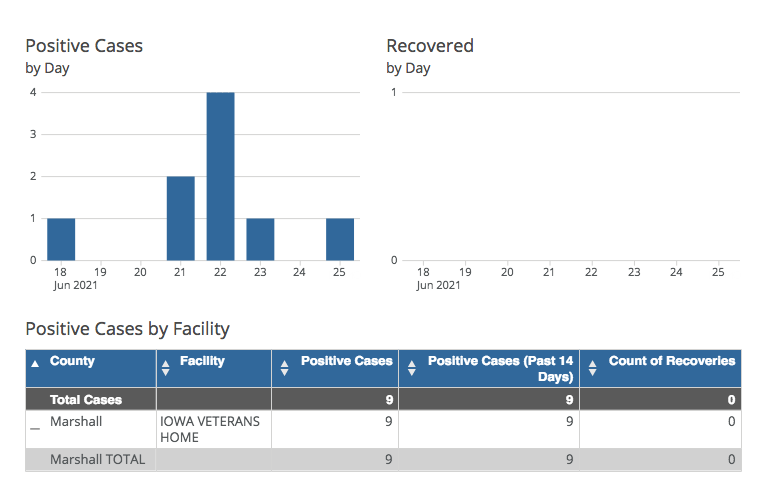This story has been updated to note that a second resident infected in the latest outbreak has died.
Two of the seven Iowa Veterans Home residents who recently contracted COVID-19 have died, the home told relatives and guardians. The first resident who passed away “was in end of life care prior to testing positive” for coronavirus, an email sent on July 2 said. The message announcing the second death on July 4 did not provide further details.
All residents and staff affected by the latest coronavirus outbreak–the fifth at the state-run facility in Marshalltown–had been living or working in the Malloy 3 unit, which “remains in isolation.” Five of the residents who tested positive in late June returned from the facility’s COVID unit to Malloy 3 last week.
According to previous emails the facility sent to relatives and guardians, the residents who became infected in late June were all vaccinated for COVID-19.
The veterans home has repeatedly tested all residents and staff working in the Malloy building. The tests conducted on July 2 all came back negative, the email said.
Data compiled by the federal government shows five previous COVID-19 deaths at the Iowa Veterans Home: one in August 2020, two in November, and two in December. Many of Iowa’s long-term care facilities lost more residents to the virus despite being much smaller than the veterans home.
VETERANS HOME BACKS OFF ON CLAIM OF “NEW” VARIANT
Early last week, the Iowa Veterans Home informed relatives and guardians that analysis at the State Hygienic Laboratory indicated the Delta variant of COVID-19 did not cause the outbreak. Those messages stated, “It turns out that we did have a variant, but it was a new variant without a specific name.”
The Iowa Department of Public Health did not answer several of Bleeding Heartland’s questions about that variant. (When was it first identified? Has it been found in counties other than Marshall? If so, in which ones?) Instead, the department’s spokesperson Sarah Ekstrand responded in a June 30 email,
The already-existing variant of the virus identified at the Iowa Veteran’s Home is not a variant of interest or variant of concern.
Just like other viruses, the Sars-CoV-2 virus can change over time. This virus has demonstrated a generally low mutation rate when compared to other RNA viruses such as HIV and influenza virus.
IDPH is working with IVH to help them better understand the nature of the virus and how to communicate this information with their residents, families and guardians.
On July 1 and July 2, the veterans home’s emails to relatives and guardians contained almost identical wording.
The variant of the virus identified at the Iowa Veterans Home is not a variant of interest or variant of concern. It is also not a “new” variant of the virus. Just like other viruses, the Sars-CoV-2 virus can change over time. This virus has demonstrated a generally low mutation rate when compared to other RNA viruses such as HIV and influenza virus.
I don’t know the threshold for deciding whether any given variant is “of interest” or “of concern.” In general, COVID-19 infections in fully vaccinated people do not cause serious illness. However, the infection appears to have been fatal in one of the seven Iowa Veterans Home residents who recently became ill.
The facility is offering vaccination clinics every other Tuesday afternoon, where all residents, staff, or family members can get a COVID-19 vaccine without making an appointment in advance. The Iowa Veterans Home has said 95 percent of residents and 70 percent of employees are fully vaccinated for coronavirus.
STATE TO PROVIDE LESS INFORMATION ON NURSING HOME OUTBREAKS
The Iowa Department of Public Health will soon remove the Long Term Care facilities dashboard from Iowa’s official source for COVID-19 statistics, coronavirus.iowa.gov. The agency announced the plan in a June 29 memo to county public health departments, which wasn’t published online. Here it is in full (hat tip to Sara Anne Willette):
Beginning on July 7, the state website will be updated only once a week on Wednesdays, rather than several times a day. The memo says that after the long term care page is removed, the main page at coronavirus.iowa.gov will list “Number of Long Term Care with a reportable outbreak each week.” (The state considers three or more COVID-19 infections among nursing home residents to qualify as an outbreak; some states report outbreaks if even one resident or staff member is infected.)
I sought to confirm whether the state will stop listing facility names and counties, and asked what would be the value of publishing only the number of long-term care outbreaks, without specific names or locations. Ekstrand indicated she would reply after the holiday weekend, so I will update this post as needed.
With the highly transmissible Delta variant becoming more prevalent in Iowa and active infections and hospitalizations on the rise, Iowans should not lose the ability to find out which nursing homes have new clusters of COVID-19 cases.
Historical data about COVID-19 outbreaks in Iowa nursing homes should remain easily accessible, thanks to the Des Moines Register’s searchable database, which draws on information from the U.S. Centers for Medicaid and Medicare Services. Nick Coltrain reported for the Register on June 29 that 57 of Iowa’s 431 nursing homes experienced a dozen or more resident fatalities from COVID-19.
The highest death toll was at Dunlap Specialty Care in Harrison County, where 36 residents died in a 57-bed facility. Three other Harrison County nursing homes also lost residents to the pandemic: 22 died at Rose Vista Home, 22 died at Longview Home, and two died at Westmont Healthcare Community. Harrison has the highest per capita COVID-19 death rate among Iowa’s 99 counties and ranked 54th among all counties nationally on that metric in early June.
Ida County has the second-highest per capita death rate and ranked 58th nationally last month. The Des Moines Register’s database shows three nursing homes in that county. The Good Samaritan Society had fifteen COVID-19 deaths, Willow Dale Wellness Village had twelve deaths, and Morningside Care Center had zero deaths (it was also among the small minority of nursing homes that had no COVID-19 cases among residents).
Ringgold is the only other Iowa county that recently ranked in the top 100 nationally (at 74th place) for per capita COVID-19 deaths. The Register’s database shows outbreaks at both nursing homes listed for the county: eight residents died at the Mount Ayr Health Care Center and seven died at the Clearview Home.
UPDATE: The Iowa Veterans Home informed relatives and guardians on July 6 that another employee tested positive that day, but all residents in the Malloy building were tested again, “and all came back negative.” The email did not clarify whether the latest employee who tested positive also worked in the Malloy 3 unit, where the other recent cases were concentrated.
No residents are currently in the home’s COVID unit.
A June 22 email to families and guardians mentioned that four staff members had tested positive that day, so the latest positive test should bring the total up to twelve (seven residents, five staff). As of July 6, the soon-to-be-disappearing long term care page on the state’s website showed only nine total cases at the Iowa Veterans Home.
Top photo of gates at Iowa Veterans Home in Marshalltown first appeared on the facility’s website.




1 Comment
I might have just trusted an IDPH opinion before the pandemic...
…but the IDPH, during the pandemic, flung my trust on the ground and stomped it repeatedly. And I know other Iowans who feel the same way. Congratulations, IDPH, you have destroyed the trust of some Iowans who would ordinarily have been among the first to listen to you.
PrairieFan Sun 4 Jul 8:31 PM